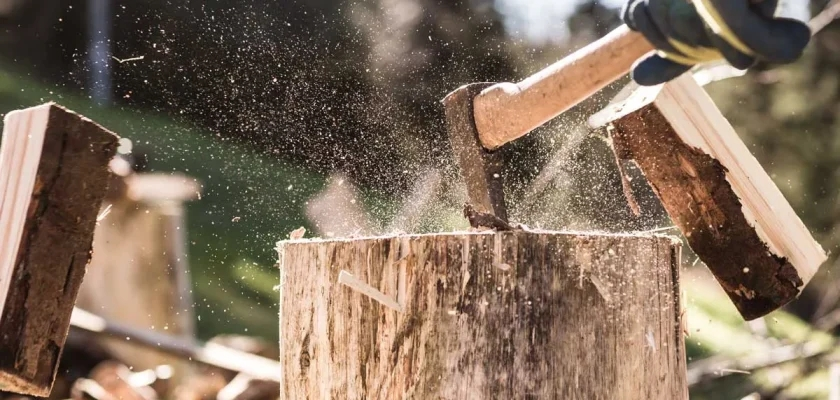Efficient wood chopping is a vital skill for anyone relying on firewood for heating, cooking, or enjoying outdoor fires. Whether preparing for the long winter months or simply stocking up for occasional use, employing effective wood-cutting techniques can significantly reduce the physical exertion and time involved. By carefully selecting the appropriate type of wood, utilizing the right tools and maintaining them properly, establishing a safe and organized work area, and mastering efficient chopping techniques, individuals can streamline the entire process and make it considerably more energy-efficient. Furthermore, understanding the best practices for stacking, storing, and even the optimal seasons for chopping wood contributes to a smoother and more productive experience.

The choice of wood significantly impacts the ease and efficiency of chopping. Hardwoods like oak, maple, and hickory, while providing long-lasting and high-heat fuel, demand more effort to split due to their denser grain. Conversely, softwoods such as pine and cedar are easier to chop but tend to burn more quickly and produce a higher amount of creosote. The optimal approach is to utilize well-seasoned wood, which has undergone a drying period of at least six months. Properly dried wood splits with significantly less effort and burns cleaner, generating less smoke and residue, ultimately making the entire process more efficient and environmentally sound.
The tools employed play a crucial role in the effectiveness of wood chopping. Three essential tools that significantly enhance efficiency include splitting mauls, axes, and wedges with sledgehammers. Splitting mauls, heavier than traditional axes and featuring a wedge-shaped head, are designed for efficiently splitting logs along their natural grain. Axes, with their sharper and more precise design, are particularly useful for cutting smaller logs and preparing kindling. For particularly dense or stubborn logs that resist splitting with standard tools, wedges driven by a sledgehammer provide the additional force needed to break them apart. Maintaining these tools in sharp and good working condition is paramount for preventing unnecessary strain and ensuring a faster and safer process. Regular sharpening and maintenance guarantee that each swing is as effective as possible, maximizing the energy expended.
Once the firewood has been efficiently chopped, proper stacking and storage are crucial for ensuring it remains dry and burns efficiently when needed. Piling the wood in a manner that allows for ample air circulation accelerates the drying process and effectively prevents the growth of mold and fungi. The best practice involves elevating the firewood off the ground using pallets or other logs and covering only the top of the stack to protect it from rain and snow while leaving the sides open for optimal ventilation. Properly organized woodpiles also make it easier to retrieve logs when required, minimizing wasted time and effort during retrieval.
The timing of wood chopping also plays a crucial role in overall efficiency. Chopping wood during the late summer or early fall allows for a longer drying period before the onset of the cold season, resulting in wood that is more efficient to burn. In the winter months, logs tend to split more easily due to the natural brittleness caused by freezing temperatures. Avoiding wet seasons, when the moisture content of the wood is naturally high, ensures that the chopped wood dries faster and is generally easier to work with. Planning ahead and chopping wood during these favorable conditions minimizes unnecessary effort and ensures a well-stocked supply of firewood that is ready for use when needed.
Even experienced woodcutters can fall into common pitfalls that lead to inefficiency or increase the risk of injury. Some common errors include using blunt or damaged tools, which require significantly more force and reduce accuracy; attempting to chop wood on uneven surfaces, leading to instability and wasted energy; swinging the tool with excessive force instead of utilizing proper momentum, which increases fatigue without necessarily improving results; and attempting to split wood that is still too wet or freshly cut, making the process considerably harder and less effective. By being mindful of these potential issues and actively working to avoid them, wood chopping can become a much more efficient and safer task.
Sustainable wood chopping practices also contribute to environmental conservation. Responsibly sourcing firewood from well-managed forests ensures the long-term health of tree populations and helps prevent deforestation. Furthermore, utilizing dry, properly seasoned wood for burning minimizes the production of smoke and harmful emissions, thereby improving air quality. Individuals who rely on wood for heating can further reduce their environmental footprint by choosing energy-efficient stoves and fireplaces that are specifically designed to burn wood cleanly and efficiently.

In conclusion, optimizing the wood chopping process involves a holistic approach that integrates the selection of appropriate wood, the use and maintenance of the right tools, the establishment of a safe and efficient workspace, and the mastery of effective splitting techniques. How we chop wood to save time and energy hinges on these key elements, along with an awareness of seasonal timing and proper storage methods. By consciously avoiding common mistakes and considering factors such as personal safety and environmental impact, chopping firewood can become a more manageable, efficient, and ultimately rewarding task, ensuring a steady supply of high-quality fuel with minimal effort and waste. Whether utilizing traditional hand tools or investing in mechanical splitters, an informed and strategic approach is the key to mastering the art of efficient wood chopping.

